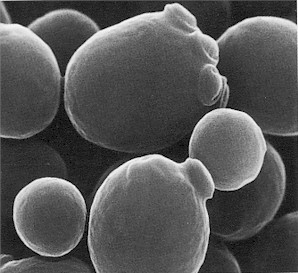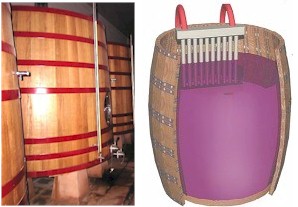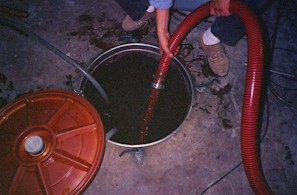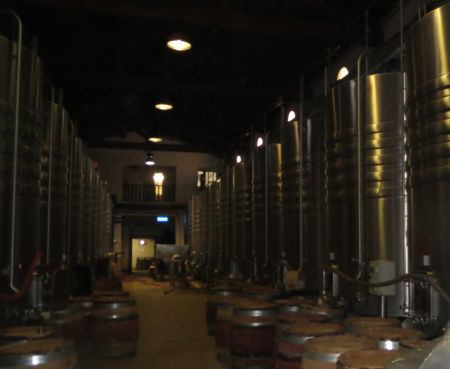The Vinification
Sorting
of grapes
The vinification starts when the grapes arrive to the cellar. During the
harvest bad bunches or grapes have to be discarded but the pickers may overlook them in the hurry of picking. Therefore a new sorting often
takes place at a sorting table in the cellar.
It's important that the fermentation can be started as quickly as possible
after the harvest to avoid any wild fermentation to start in an uncontrolled
way.
The rules of the appellation claim that at least 5% of the harvest has to
be discarded and vinified separately (the râpé). A part of these 5%
can come from the sorting of the bunches.
De-stemming
(Égrappage)
You can't say if it's common or not to let the stalks ferment together
with the grapes in Chateauneuf du Pape. According to the old traditions
there was no de-stemming but many producers do it today, some do it
always, some do it never and some do it sometimes for some varieties
and depending of the ripeness.
If de-stemming always is done the reason may be that you want to avoid
every risk of adding an unpleasant taste to the wine from unripe stalks -
herbaceous taste with a bitter
undertone.
If de-stemming is never done
the reason may be that you want to underline that the wines are
made in the traditional way and the tannins from the stalks can certainly
bring the expression of the single vintages.
The de-stemming equipment normally also crush the grapes in a gentle way
giving the optimum conditions for the following fermentation.
Alcoholic fermentation
and maceration
The alcoholic fermentation start quite quickly when the
slightly crushed grapes are transferred to the fermentation tank. At first
the natural yeast (Saccharomyces cerevisiae - see photo to
the right) from the skin of the grapes multiply and then they begin
consuming the sugar in the juice. The result of this
process is that the sugar are converted into
alcohol and carbon dioxide. The process will end when the
sugar is consumed or the alcohol percent reaches a level that kills the
rest of the yeast - approximately 15 percent.
The fermentation process requires control of the temperature as the
process itself increases the temperature in the must. White wines are
fermented slowly with lower temperature but for red wines a higher
temperature is wanted because this promotes the maceration. Normally the
fermentation will last for 7 to 30 days. The maceration process will then
also normally be finished but can be continued for some time after the end of
the fermentation if wanted. The maceration is the process where extraction of the
colour, the tannins and other wanted elements from the skin and perhaps
from the stalks of the grapes takes place.
The fermentation and maceration
can be done in different vessels. White wines are normally fermented in
steel tanks. Red wines in steel or cement tanks or great wood barrels.
For all kinds of vessels regulation of the temperature is often made by
letting cool water circulate in a system of pipes.
Trough the fermentation and maceration
processes for the red wines the wine maker makes the first determinations about
the character of the wine. He may want a straight forward wine meant to be
drunk young or a more strong structured wine with more fruit, tannin and
body meant to be kept in the cellar or in bottles for many years. The
duration of the maceration period is important.
Remontage
During the fermentation and maceration a floating layer of grape skins
will have a tendency to lie at the top of the most (the cap). Therefore
it's necessary to reassemble the must and the cap. This is done by pumping
the must over the cap or perhaps by manual or mechanical stirring.
Pressing
After the maceration
the most is separated from the pulp and transferred to the vessels for
maturation before bottling. Different presses can be used. The traditional
vertical press of wood is still used also new ones (photo to the right)
but now many use horizontal presses of steel especially for the
white wines.
Most of the wine (approximately 80%) runs freely from the tank (Vin de
goute) then some more must comes from light pressing (Vin de press). The
quality of the press wine decides if it is all blended again with the
free run wine.
Malolactic fermentation
Shortly
after the end of the primary (alcoholic) fermentation the second (malolactic)
fermentation occurs automatically. In this process malic
acid is converted into lactic acid undertaken by bacteria foremost Oenococcus
oeni. The lactic acid tastes less
sour and more friendly than the malic acid which can give the red wine a
hard and metallic character.
For the white wines this process are usually stopped because the white
wines from the warm area has a tendency to lack acid.
The malolactic fermentation can last for some time and is finished in the
vessels for maturing the wine.
Maturing
- ageing
Most
of the white wines are matured in steel tanks and bottled less than a year
after the harvest but some special cuvées are matured in wood and not
bottled before one - two years after the harvest.
Traditionally the red wine is matured in foudres (big casks of wood)
containing 30-60 hl. You can meet many different sizes of smaller casks or
barrels in Chateauneuf du Pape: demi-muids (600l) or barriques (225-228l).
The ageing/maturing period (from harvest to bottling) for the red wines
vary in Chateauneuf du Pape from one year to between two to three years.
The period vary depending of the quality of the harvest.
For the normal red Chateauneuf du Pape (not special cuvées) the aging in
wood is not done to extract tannins or taste from the wood but to let the
wine oxidize slowly and in this way bring the wanted balance to the wine and
when the producer finds this is achieved he bottles the wine.
Some producers don't use wood at all to mature the wine but only use
tanks
of steel or cement. You have to be an experienced taster to decide if wood have been used or not.
Some producers age in both tanks and wood.
Some producers mostly use foudres and perhaps smaller wood vessels for
part of the wine (demi-muids or barriques)
Some producers have no or very few foudres and use only demi-muids or
barriques.
When it comes to the special
cuvées some producers use new or newer barriques but these wines are often
produced in very tiny quantities can hardly be called typical wines from
the appellation but they can obtain high scores from the wine tasters and
high prices and in this way have some marketing effect for the producer..
Normally the red wines are bottled 18 - 24 months after the harvest.
|










